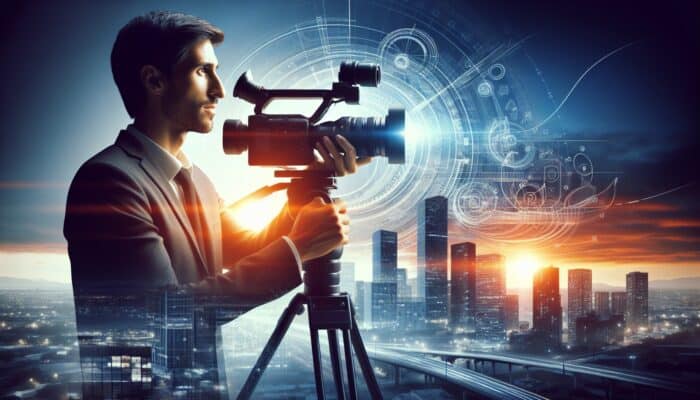Transform Your 360-Degree Video Production with Essential Software Solutions
Creating engaging and immersive 360-degree marketing videos necessitates a diverse range of software tools that simplify the production and editing processes. In today's landscape, where audiences seek out immersive experiences, choosing the right software can enhance your marketing strategies significantly, turning ordinary footage into captivating visual stories. This section delves into the essential software categories that are crucial for producing remarkable 360-degree videos, designed to captivate viewers and foster interaction.
Powerful Video Editing Solutions for Crafting 360-Degree Content

The foundation of successful 360-degree video production lies in robust video editing platforms. These advanced software solutions are specifically crafted to seamlessly integrate multiple camera feeds, ensuring smooth transitions across various angles that draw in the viewer's attention. Notable software options like Adobe Premiere Pro and Final Cut Pro offer sophisticated features specifically tailored to the nuances of 360-degree video editing. These platforms empower users to manipulate footage creatively, incorporating tools for spatial audio integration, chroma keying, and dynamic text overlays—elements that are essential for creating engaging content.
Additionally, these editing platforms typically provide intuitive interfaces along with extensive libraries of effects and transitions, greatly enhancing the visual storytelling capabilities of your marketing videos. Beyond mere stitching, advanced functionalities allow users to modify perspectives, apply colour corrections, and even introduce animations that are sure to capture attention. Furthermore, tools like CyberLink PowerDirector include dedicated modules for 360-degree video editing, making them accessible for both beginners and experienced professionals alike. Selecting the appropriate software is crucial in fully harnessing the potential of your 360-degree footage, ultimately boosting the engagement and effectiveness of your marketing efforts.
Essential 3D Modelling Software for Creating Interactive Virtual Spaces
To deliver genuinely immersive experiences, 3D modelling tools are vital for crafting virtual environments that complement your 360-degree marketing videos. Software applications such as Blender and Unity enable creators to design intricate 3D models that can be seamlessly integrated into videos, providing audiences with an interactive experience. This capability is particularly advantageous for showcasing products in innovative ways, such as developing virtual showrooms or environments that resonate deeply with your target audiences.
Moreover, these tools facilitate the addition of textures, lighting, and shadows, significantly enhancing the realism of the 3D elements presented in your videos. By utilising 3D modelling software, marketing teams can construct unique, brand-specific environments that differentiate them in a competitive marketplace. For instance, a travel agency might create a virtual tour of a destination, allowing potential clients to explore the location before making a purchase decision. The immersive capabilities of 3D modelling not only heighten viewer interaction but can also lead to increased conversion rates.
Are You Prepared to Embark on Your 360-Degree Video Adventure?
Creative Animation Software for Enhancing Viewer Engagement
Incorporating dynamic animated elements can significantly elevate viewer engagement in 360-degree videos. Tools such as Adobe After Effects and Toon Boom Harmony empower marketers to embed animations that infuse life into static visuals. These animations can effectively guide viewers through the narrative of the video, emphasising essential messages and ensuring clarity in communication.
Furthermore, animation software allows for the creation of custom graphics and transitions that elevate the overall production quality of your marketing videos. By introducing animated features, marketers can captivate their audiences in ways that traditional video formats cannot, thereby maintaining viewer interest throughout the entirety of the content. Moreover, animations can be tailored to reflect the brand's identity, ensuring consistency across all marketing channels. This approach not only enriches the storytelling aspect of 360-degree videos but also fortifies brand recognition and loyalty among viewers.
High-Performance Cameras for Capturing Stunning 360-Degree Footage

Equipping yourself with the right cameras is essential for capturing breathtaking 360-degree footage. Whether you are a seasoned expert or just beginning your journey in video marketing, the selection of camera can greatly impact the quality of your content. Here, we examine the most effective cameras available on the market, meticulously designed for 360-degree filming.
Top Professional 360-Degree Cameras for High-Resolution Content Creation
When it comes to obtaining high-resolution 360-degree content, investing in professional-grade cameras such as the Insta360 ONE X2 or the Ricoh Theta Z1 can deliver unmatched quality. These cameras are engineered specifically for immersive video capture, featuring multiple lenses that enable users to record in stunning 4K or higher resolutions. This level of detail is crucial for compelling marketing videos, as potential customers are more likely to engage with visually rich content.
Moreover, premium 360-degree cameras typically include advanced stabilisation features, ensuring that footage remains smooth even in brisk shooting scenarios. For brands aiming to document travel experiences or extreme sports events, these cameras provide the reliability and quality necessary. Their ability to capture footage in low-light conditions is another significant advantage, allowing for detailed recordings during nighttime or in dimly lit settings.
Versatile Action Cameras with 360-Degree Filming Features
For those seeking flexibility in their filming gear, action cameras like the GoPro MAX offer impressive 360-degree filming capabilities, along with outstanding performance across a variety of environments. These cameras are designed to be robust and portable, making them suitable for both indoor and outdoor applications. Their compact form allows for easy transport, while their capacity to capture 360-degree footage enables marketers to create engaging content spontaneously.
Additionally, action cameras often come equipped with live streaming capabilities and various shooting modes, promoting spontaneity in content creation. This adaptability is particularly beneficial for brands looking to engage audiences with real-time storytelling, whether through live events, product launches, or behind-the-scenes glimpses. The combination of portability and high-quality 360-degree capture positions these cameras as essential tools for innovative marketing strategies.
Smartphone Accessories for Enhancing 360-Degree Filming Capabilities

In an era where smartphones are ubiquitous, harnessing mobile technology for 360-degree filming is both accessible and effective. Accessories such as the Insta360 ONE R and the Ricoh Theta SC2 are specifically designed to transform standard smartphones into powerful 360-degree cameras. These tools enable users to effortlessly capture immersive content without requiring extensive equipment.
Smartphone accessories also provide significant advantages for small businesses and independent creators, offering a cost-effective solution for producing high-quality 360-degree videos. With user-friendly applications that allow for quick editing and sharing directly from devices, marketers can swiftly connect with audiences and broaden their reach. This widespread access to technology empowers a wider range of creators to explore 360-degree content, fostering innovation and creativity in global marketing initiatives.
Audio Equipment Crucial for Crafting an Immersive Sound Experience
While stunning visuals are essential, high-quality audio is equally important for creating compelling 360-degree marketing videos. Sound can greatly enhance the immersive experience, allowing viewers to feel as though they are truly part of the depicted environment. Here, we take a closer look at the audio equipment that can elevate your 360-degree video production.
Specialised 360-Degree Microphones for Capturing Surround Sound Effectively
To capture audio from all directions, investing in specialised 360-degree microphones can transform your audio production. Devices such as the Sennheiser AMBEO VR Mic or the Zoom H3-VR are engineered to record spatial audio, allowing viewers to experience sound as if they are situated within the environment portrayed in the video. This level of audio fidelity can significantly enhance audience engagement and immersion.
Utilising 360-degree microphones is particularly advantageous in scenarios involving live events or performances, where capturing the atmosphere is crucial. The immersive audio experience can greatly amplify marketing videos for events such as product launches or festivals, making viewers feel as though they are physically present at the occasion. This depth of audio engagement can lead to improved viewer retention rates and, ultimately, increased interest in the brand.
Professional Audio Editing Software for Superior Sound Quality
To complement the stunning visuals of 360-degree marketing videos, high-quality audio editing software is essential for refining audio tracks. Programs like Adobe Audition and Avid Pro Tools provide robust tools for mixing and editing sound, ensuring that the audio quality matches the high standards set by the visuals. These editing platforms facilitate the incorporation of background music, sound effects, and voiceovers, all optimised for spatial audio formats.
Utilising audio editing software enables marketers to enhance the overall viewer experience by making precise adjustments to audio levels, panning, and effects. This level of control is crucial for creating an immersive audio environment that resonates with viewers and retains their engagement throughout the video. By ensuring high-quality audio, brands can significantly improve their storytelling and increase the likelihood of social sharing and engagement across multiple platforms.
Ambisonic Audio Technology for Crafting Enhanced Soundscapes
Ambisonic technology is revolutionising how sound is captured and manipulated in 360-degree marketing videos. This sophisticated audio format allows for the creation of multidimensional soundscapes that amplify the immersive quality of the video. By employing ambisonic microphones, marketers can capture audio in a way that mimics real-world listening experiences, placing viewers directly within the environment depicted in the footage.
Integrating ambisonic audio is particularly beneficial for virtual reality experiences, as it facilitates more natural interactions with sound in a 3D space. This technology can be applied in various marketing contexts, from product demonstrations to immersive storytelling campaigns. The ability to manipulate sound direction and distance creates a compelling narrative that can draw viewers deeper into the content, ultimately leading to higher engagement and improved conversion rates.
Spatial Audio Headphones for Optimal Sound Playback Experience
To fully appreciate the immersive audio experience created by 360-degree videos, viewers require the right playback equipment. Utilising spatial audio headphones, such as those developed by Apple and Bose, enhances the overall experience by delivering precise, directional sound. This technology allows users to perceive audio as if they are physically present in the environment, creating a more engaging viewing experience.
By recommending spatial audio headphones alongside their 360-degree videos, brands can ensure that their audiences experience the content exactly as intended. This technology can transform typical video consumption into an immersive journey. Marketers can leverage spatial audio to create unforgettable experiences that resonate with their audiences, promoting social sharing and engagement across various platforms.
Effective Soundproofing Solutions for Achieving Superior Audio Quality
To obtain optimal audio quality, implementing soundproofing solutions during the recording process is vital. Techniques such as using sound-absorbing panels, portable vocal booths, or acoustic treatments can significantly reduce external noise, ensuring a more focused and immersive sound experience. This is particularly crucial when recording in environments with unpredictable acoustics, such as outdoor events or bustling locations.
Proper soundproofing not only enhances direct audio quality but also elevates the overall production value of the 360-degree video. By minimising distractions, viewers can concentrate on the narrative and visuals, resulting in enhanced viewer retention and engagement. Brands that prioritise high audio quality alongside stunning visuals will stand out in an increasingly competitive digital landscape.
Revolutionary Virtual Reality Platforms for Effective Video Distribution
Once your exceptional 360-degree marketing videos are produced, selecting the right distribution platforms is crucial for maximising reach and audience engagement. Virtual reality and immersive platforms offer unique opportunities for sharing content that traditional media cannot replicate. Here’s a closer look at how to effectively distribute your 360-degree videos.
Ensuring Compatibility with VR Headsets for Enhanced Viewing Experiences
For optimal viewing experiences, it is essential to ensure that your 360-degree videos are compatible with a variety of VR headsets. Popular headsets, such as the Oculus Quest 2, HTC Vive, and PlayStation VR, provide immersive environments that enable viewers to interact fully with your content. Marketers should take these platforms into account during production to ensure their videos are accessible and provide the intended immersive experience.
Creating content optimised for VR headsets requires an understanding of the unique features and capabilities of each device. For instance, high-resolution video and immersive spatial audio are essential for engaging users with VR headsets. By tailoring your videos for these platforms, you can significantly enhance viewer satisfaction and increase the likelihood of shares and recommendations across social media networks.
Leveraging VR Video Hosting Services for Maximum Audience Reach
To effectively host and stream your 360-degree marketing content, utilising specialised VR video hosting services is crucial. Platforms such as Vimeo, YouTube, and Oculus Venues offer dedicated spaces for 360-degree video content, enabling marketers to reach a broader audience. These services often come with features that enhance viewer engagement, such as interactive hotspots and analytics tools.
Employing VR video hosting services also facilitates easier sharing across social media platforms, encouraging greater audience interaction. These platforms allow seamless integration of comments, likes, and shares, fostering a community around your content. By leveraging these hosting services, brands can effectively amplify their reach and engage with potential customers on a global scale.
Incorporating Interactive VR Features to Drive Engagement
Integrating interactive elements within your VR videos can significantly enhance viewer engagement and overall marketing effectiveness. Features such as clickable hotspots, 360-degree navigation, and interactive storytelling empower users to explore content at their own pace. This level of interactivity deepens viewer investment in the video, resulting in higher retention rates and a greater likelihood of conversions.
Interactive features also enable brands to collect valuable data on viewer behaviour, allowing for more targeted marketing strategies in the future. Engaging users through interactive experiences fosters increased loyalty and brand recognition, as consumers appreciate the effort put into crafting memorable content. This approach is particularly effective for sectors like real estate, tourism, and education, where potential buyers value the opportunity to explore offerings in depth before making a decision.
Monetisation Strategies for Optimising Return on Investment (ROI) from VR Content
To maximise the return on investment from your VR video content, exploring various monetisation strategies is essential. Options such as subscription services, pay-per-view models, and in-video advertising can generate revenue while providing value to your audience. By strategically selecting how to monetise your VR content, you can create sustainable income streams while enhancing viewer experiences.
Incorporating advertising within your 360-degree videos can also create branded experiences that resonate with your audience. This approach allows brands to align their messages with engaging content, fostering a deeper connection with consumers. As the demand for immersive content continues to rise, exploring innovative monetisation strategies will be vital for marketers looking to leverage the opportunities presented by 360-degree videos.
Advanced Analytics Tools for Evaluating 360-Degree Video Performance
Assessing the success of your 360-degree marketing videos is crucial for understanding viewer engagement and refining future campaigns. Utilising analytics tools can provide valuable insights into how your content is performing and where adjustments may be necessary. Let’s explore the key metrics and features that analytics tools can offer.
Key Viewer Engagement Metrics for Effective Performance Analysis
Monitoring viewer engagement metrics is essential for evaluating the effectiveness of your 360-degree videos. Metrics such as play rates, watch time, and interactions provide insights into how viewers are connecting with your content. Platforms like Google Analytics and YouTube Analytics furnish comprehensive data on viewer behaviour, enabling you to identify which elements of your videos resonate most with your audience.
Understanding engagement metrics empowers marketers to refine their strategies and develop more compelling content in the future. For instance, if analytics indicate that viewers drop off at a specific moment in your videos, this may suggest that the content is less engaging or that the pacing requires adjustment. By continually analysing viewer engagement, brands can adapt and evolve their content to better align with audience expectations.
Utilising Heatmap Analysis to Understand Viewer Attention
Heatmap analysis elevates viewer engagement tracking by visually representing which areas of your 360-degree videos capture the most attention. By employing tools like Visier or Heatmap.js, marketers can gain insights into where viewers are looking and interacting within their videos. This information is invaluable for optimising content and ensuring that key messages are effectively communicated.
Heatmaps can reveal behavioural patterns, such as areas where users frequently pause, rewind, or skip forward. By identifying these trends, brands can make data-driven decisions about structuring future videos, ensuring that essential elements are highlighted and easily accessible. This analytical approach enhances the effectiveness of marketing campaigns and can lead to improved viewer satisfaction.
Tracking Conversions to Measure Video Effectiveness
Monitoring conversions from your 360-degree marketing videos is vital for evaluating their overall effectiveness. Utilising tracking tools such as Google Tag Manager can help marketers attribute leads and sales directly to specific video campaigns. By understanding how viewers interact with your content and how it influences their purchasing behaviour, you can better tailor future efforts to drive results.
Tracking conversions also enables the identification of successful strategies that can be replicated in future video content. For example, if a particular call-to-action in your video leads to higher conversion rates, it can serve as a blueprint for upcoming campaigns. By continuously refining their approach based on conversion data, brands can maximise the impact of their 360-degree videos on sales and customer engagement.
Retention Rate Analysis for Optimising Content
Analysing retention rates is critical for understanding how long viewers remain engaged with your 360-degree videos. High retention rates indicate that your content effectively captures viewer interest, while low rates may suggest the need for adjustments. Tools like Wistia and Vidyard provide detailed analytics on retention, enabling marketers to identify which segments of the video maintain attention for extended durations.
Examining retention rates also helps pinpoint which elements of the video may require improvement. For instance, if retention drops significantly at a certain moment, it could indicate that the content is losing focus or failing to engage. By continually monitoring retention rates, marketers can optimise their content to ensure that each video captivates audiences from start to finish.
Enhancing 360-Degree Videos Through Strategic Post-Production Techniques
After filming and editing, the post-production phase presents numerous opportunities to enhance the quality and impact of your 360-degree videos. Implementing specific techniques can elevate your content and ensure it stands out in a competitive marketplace. Here’s a closer look at the enhancements that can be made during this critical stage.
Colour Grading and Correction to Amplify Visual Appeal
Colour grading and correction can dramatically affect the visual attractiveness of your 360-degree videos. By employing software such as DaVinci Resolve or Adobe Premiere Pro, marketers can adjust colours, contrasts, and brightness levels to create a cohesive and engaging visual narrative. These enhancements are particularly vital in 360-degree videos, where maintaining consistent colour across various angles can be challenging.
Effective colour grading can evoke specific emotions and establish the tone for your video, making it more compelling for viewers. For example, warmer tones may create a sense of comfort or nostalgia, while cooler tones can evoke feelings of professionalism or serenity. By thoughtfully considering the colour grading process, brands can enhance their storytelling and forge deeper connections with their audiences.
Integrating Special Effects for Compelling Storytelling
Incorporating special effects can add layers of creativity and impact to your 360-degree marketing videos. Software options like Adobe After Effects offer extensive libraries of effects that can be tailored to align with your brand’s identity. Whether it involves adding dynamic transitions, visual elements, or interactive overlays, special effects can elevate your content and engage viewers on a deeper level.
Special effects also enrich storytelling, making your videos more memorable. For instance, brands can utilise effects to emphasise product features or create immersive environments that draw viewers in. By strategically integrating special effects, marketers can add a unique flair to their 360-degree videos, distinguishing them from traditional content.
Utilising Stabilisation Software for Smooth and Professional Footage
Achieving smooth and professional-looking footage in 360-degree videos is vital for viewer satisfaction. Stabilisation software, such as Adobe Premiere Pro’s Warp Stabilizer, can be employed to minimise shaky footage and enhance the overall viewing experience. This is particularly important in dynamic filming environments, where movement can frequently lead to uneven shots.
By utilising stabilisation tools, brands can produce polished and visually appealing videos that maintain viewer engagement. Smooth footage is not only easier to watch but also allows audiences to focus on the content rather than being distracted by shaky camera work. Prioritising stabilisation during post-production is a crucial step in delivering high-quality 360-degree marketing videos.
Enhancing Audio for a Rich Multi-Layered Experience
To create a truly immersive experience, audio enhancement techniques should not be overlooked in post-production. Techniques such as compression, equalisation, and reverb can significantly improve audio quality, ensuring it aligns with the high standards set by the visuals. By dedicating time to audio enhancement, marketers can create a more cohesive experience that resonates with viewers.
Incorporating background music and soundscapes can also add depth to your 360-degree videos. Thoughtfully selecting audio elements that complement the visuals can evoke emotional responses and enrich storytelling. By focusing on audio enhancements, brands can create a multi-layered experience that captivates viewers and encourages them to engage with the content.
Frequently Asked Questions (FAQs)
What are the most effective tools for creating 360-degree marketing videos?
The most effective tools encompass video editing software such as Adobe Premiere Pro and Final Cut Pro, 3D modelling tools like Blender, and specialised cameras such as the Insta360 ONE X2 and Ricoh Theta Z1.
How can I boost viewer engagement in my 360-degree videos?
Enhancing viewer engagement can be accomplished by incorporating interactive elements, leveraging high-quality audio, and delivering compelling storytelling that resonates with your target audience.
What audio equipment is recommended for 360-degree videos?
Specialised 360-degree microphones, such as the Sennheiser AMBEO VR Mic, along with spatial audio headphones, can significantly enhance the immersive sound experience in your videos.
Are there specific VR platforms designed for hosting 360-degree videos?
Yes, platforms such as YouTube, Vimeo, and Oculus Venues provide specialised spaces for hosting and streaming 360-degree video content.
How can heatmap analysis improve my 360-degree videos?
Heatmap analysis reveals which segments of your videos capture the most attention, allowing you to optimise content and ensure that key messages are communicated effectively.
What are the advantages of using action cameras for 360-degree filming?
Action cameras, like the GoPro MAX, offer versatility, portability, and durable performance, making them ideal for capturing high-quality 360-degree footage in diverse environments.
How does colour grading impact 360-degree videos?
Colour grading enhances the visual appeal and emotional resonance of your videos, creating a cohesive narrative that connects with viewers and draws them into the content.
What role does stabilisation software play in producing 360-degree videos?
Stabilisation software ensures smooth and professional-looking footage, which is essential for maintaining viewer engagement and delivering high-quality content.
What are some effective strategies for monetising VR content?
Effective monetisation strategies include subscription services, pay-per-view models, and incorporating in-video advertising, all of which can generate revenue while delivering value to your audience.
How can I track conversions from my 360-degree videos?
Using tracking tools like Google Tag Manager can help monitor conversions and attribute leads and sales directly to specific video campaigns, offering valuable insights for future marketing efforts.
Explore our world on X!
The Article Best Tools for Creating 360-Degree Marketing Videos was first published on https://marketing-tutor.com
The Article 360-Degree Marketing Video Creation Tools You Need Was Found On https://limitsofstrategy.com


